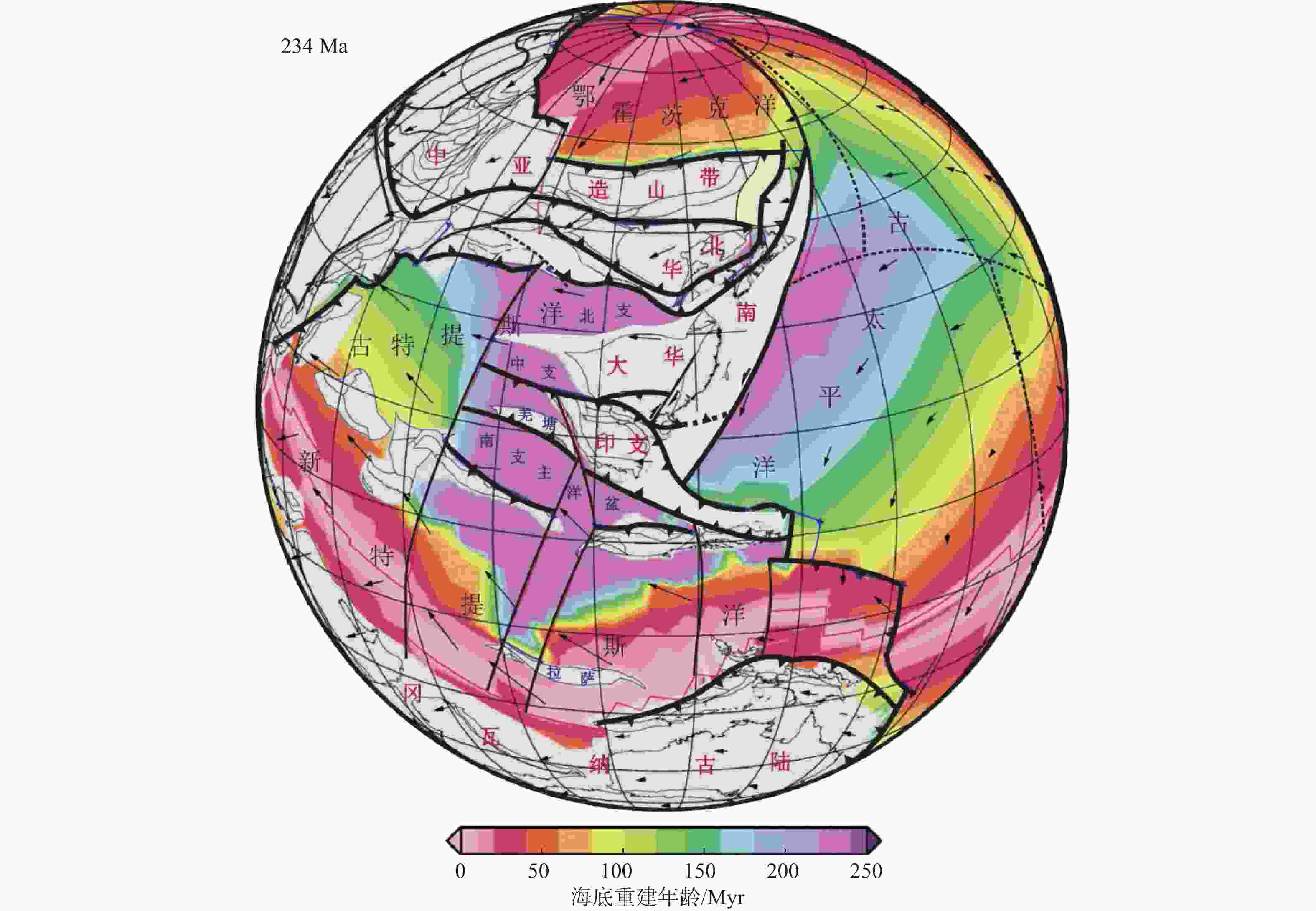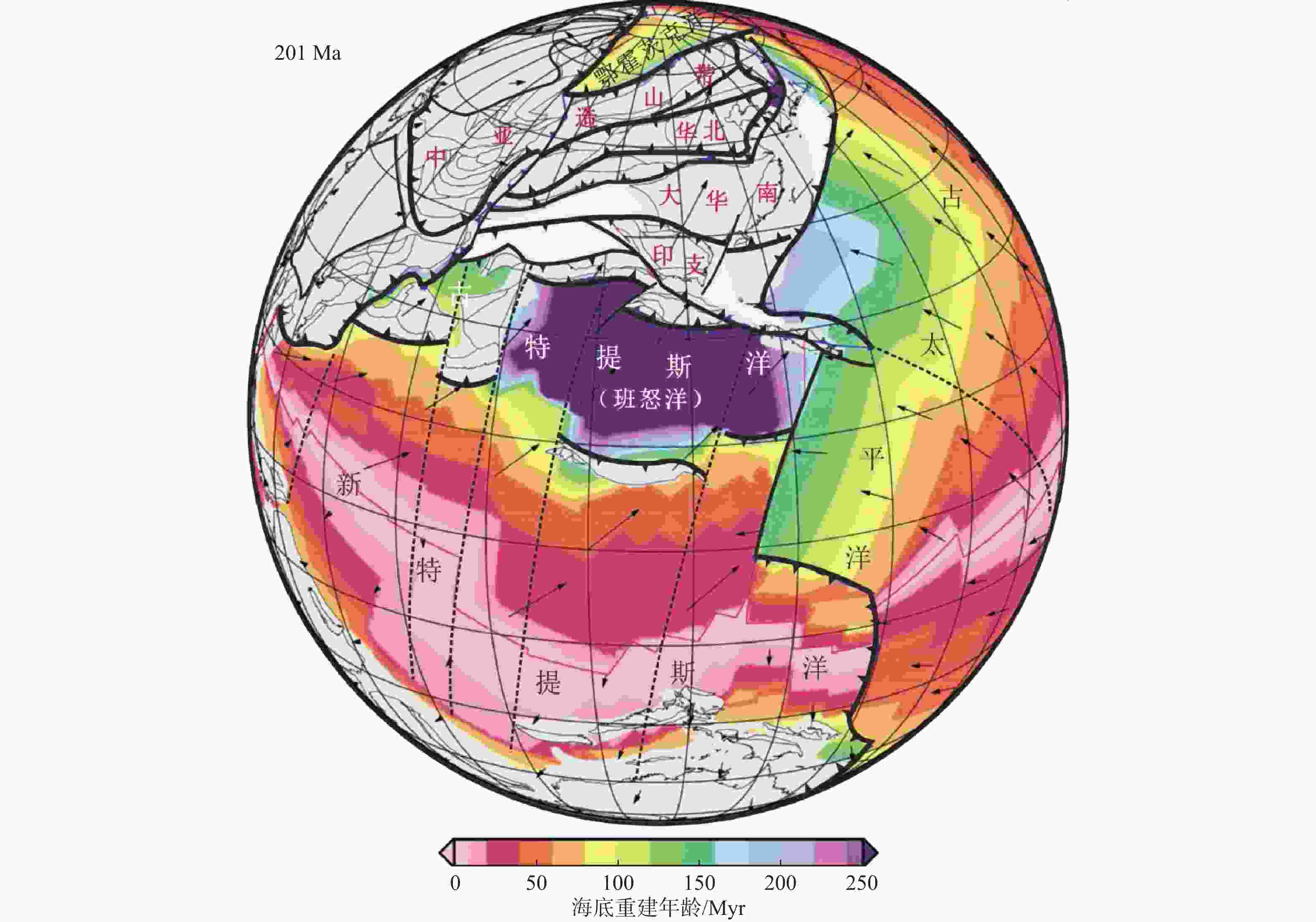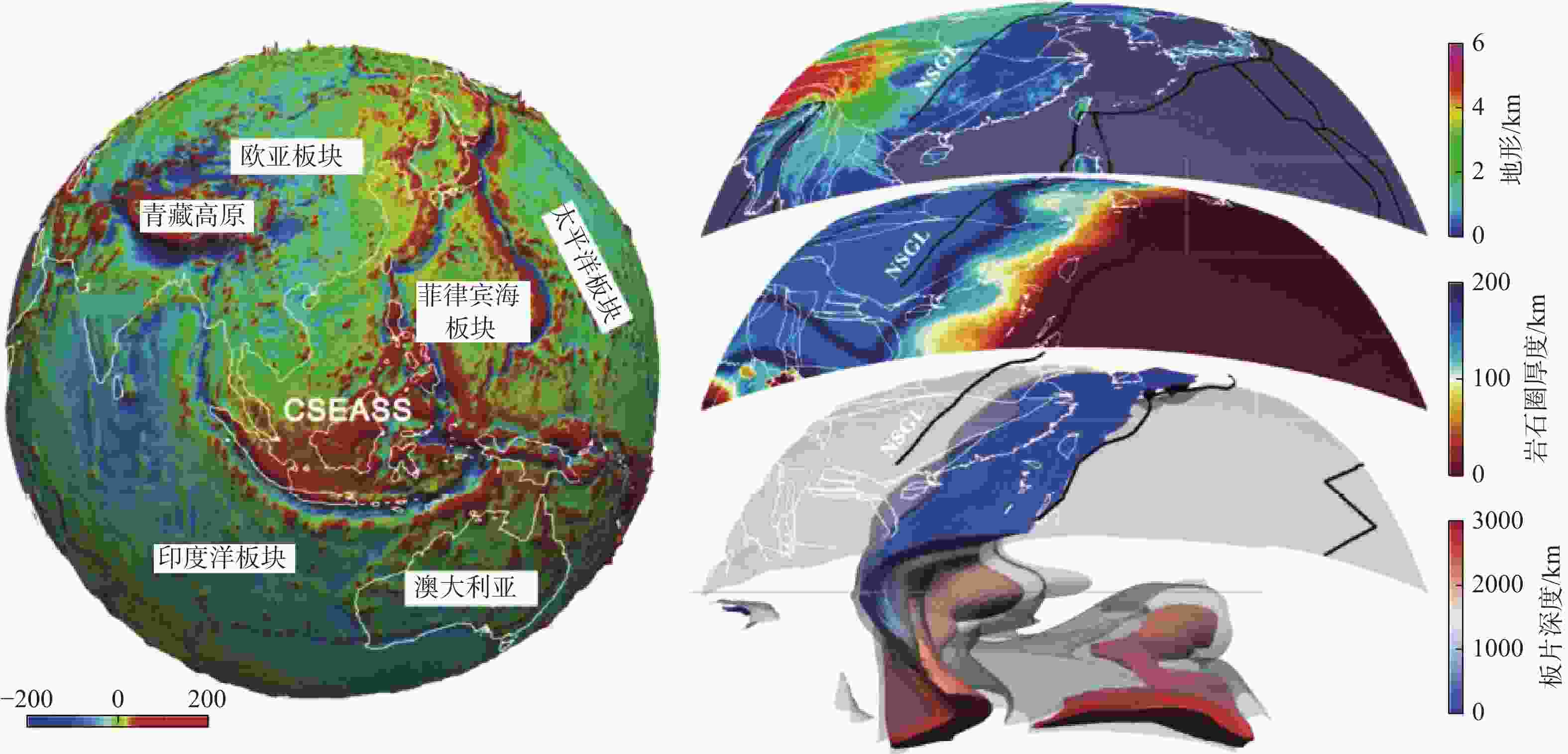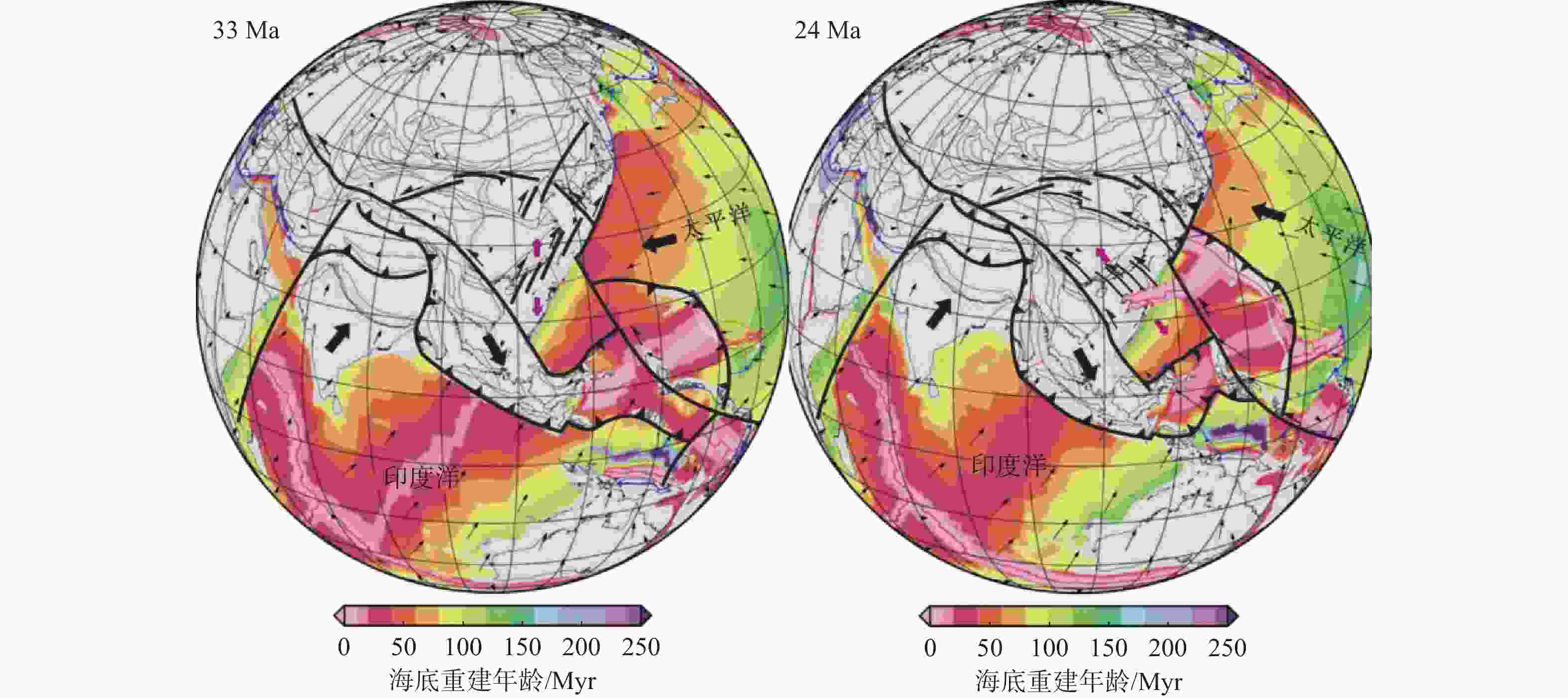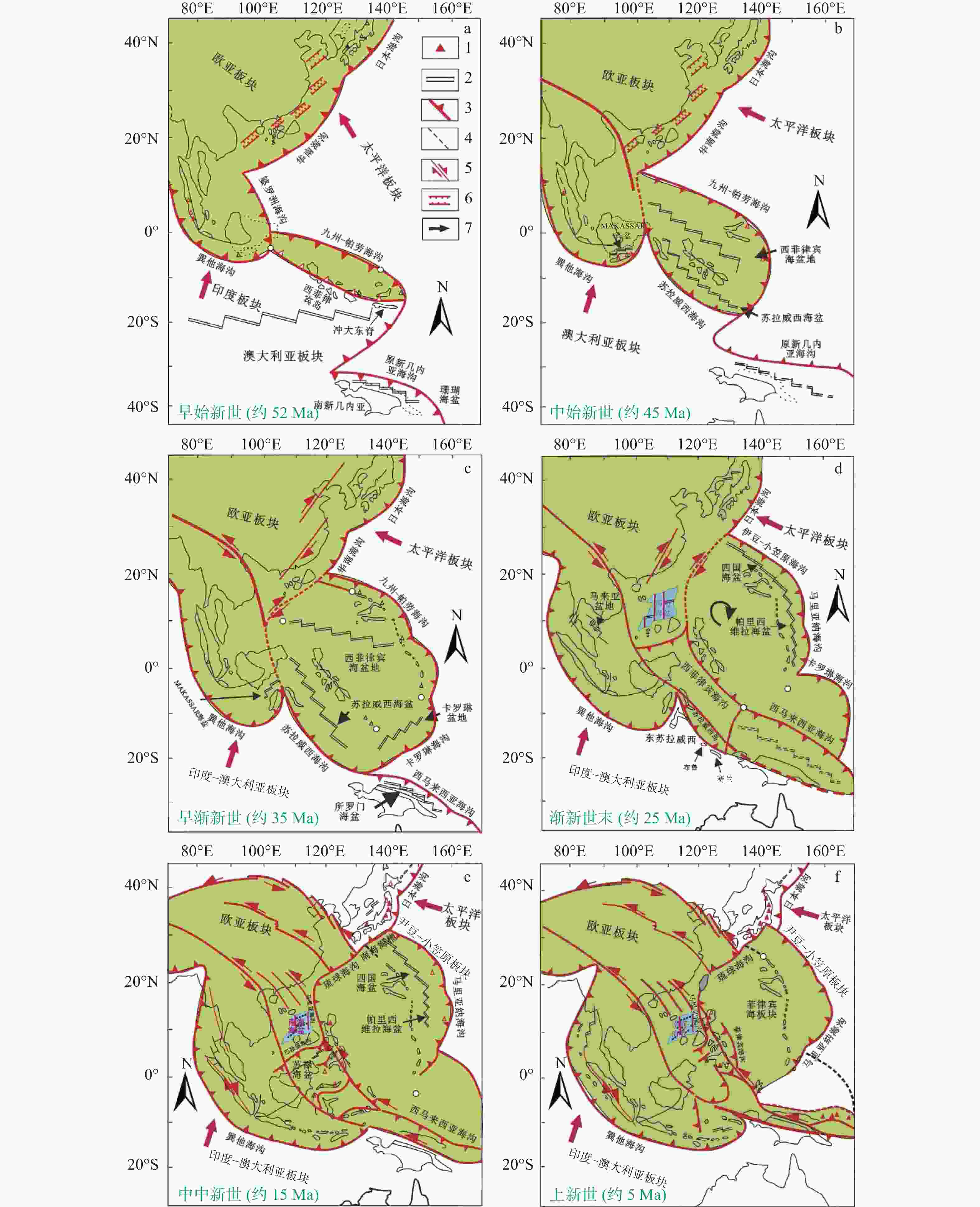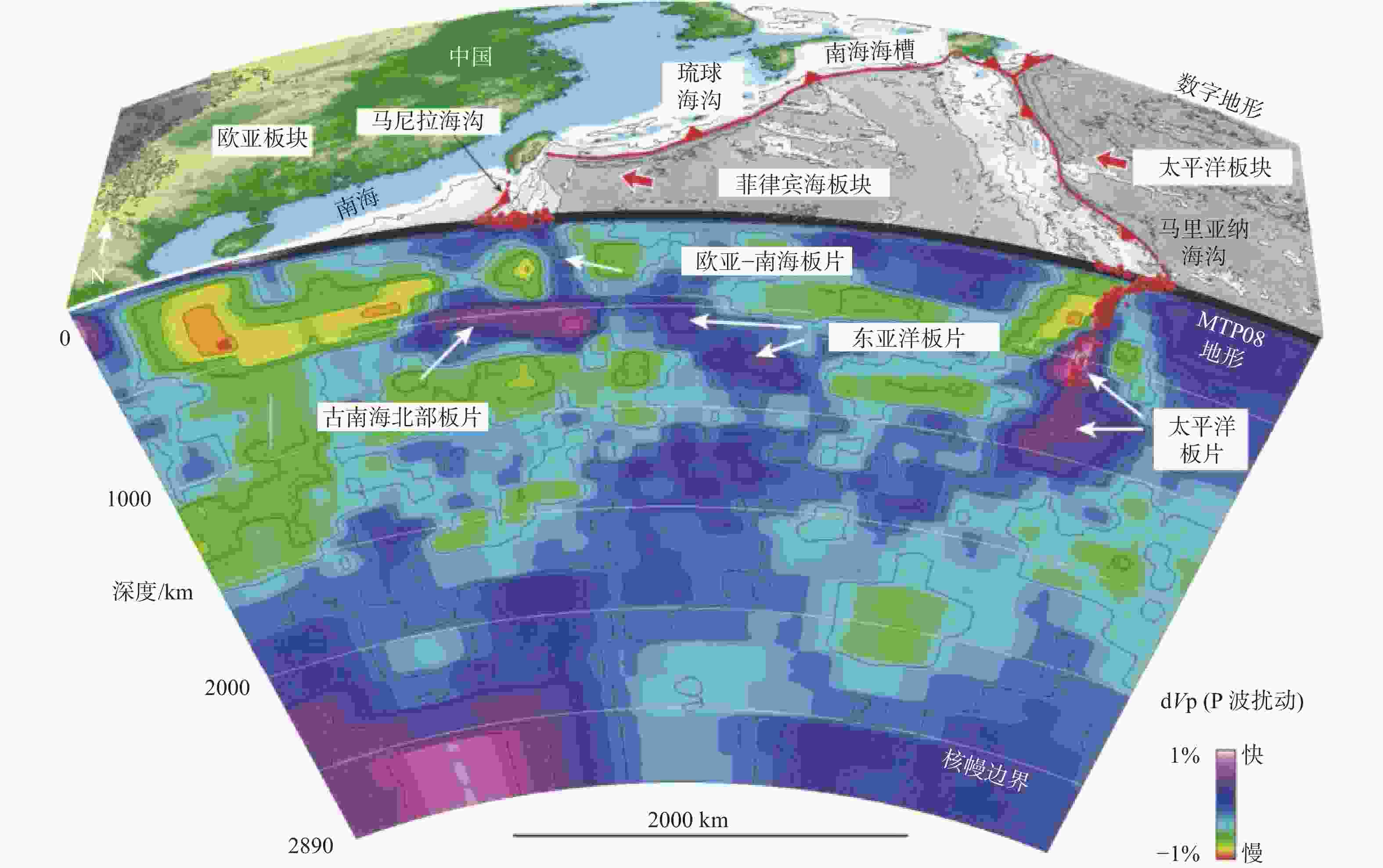Tectonic evolution of the South China Ocean-Continent Connection Zone: Transition and mechanism of the Tethyan to the Pacific tectonic domains
-
摘要: 南海北部陆缘位于大华南地块洋陆过渡带南段的关键核心段落,曾处于特提斯洋构造域与(古)太平洋构造域交接地带,是印度洋构造动力系统与太平洋构造动力系统波及的共同地区。然而,以往研究和勘探程度较低,特提斯构造域与太平洋构造域交接转换区域的大地构造背景、过程、机制始终不够明确。基于南海北部陆缘地震剖面,不仅关注该区新生代盆地结构构造,以服务该区油气精准勘探,并且试图以此解剖、揭示该区中生代基底结构特征,进而探索新生代南海海盆打开、扩张、停滞到消亡过程的前生今世。对珠江口盆地地震剖面解析和华南陆缘野外构造研究表明:华南地块洋陆过渡带先后经历了中生代印支期碰撞造山、燕山早期增生造山、燕山晚期压扭造山三个过程;随后进入新生代,又经历了早期北东东—南西西走向正断层主控下的弥散性裂解成盆、中期北东—北北东走向张扭断裂主控下的右行走滑拉分成盆、晚期北西—北西西向张扭断裂主控下的左行走滑拉分成盆三期伸展构造叠加。总体上,该区特提斯洋构造体系向太平洋构造体系的转换过程经历了四个阶段:古特提斯洋构造体系向新特提斯洋构造体系转换、新特提斯洋构造体系向古太平洋构造体系转换、新特提斯洋构造体系向太平洋构造体系转换及古太平洋构造体系向太平洋构造体系的转换。东亚洋陆过渡带的构造转换折射出地球深浅部动力系统驱动“东亚大汇聚”的长期机制,即东南亚环形俯冲驱动体系、太平洋LLSVP和非洲LLSVP的深部动力系统(统称为海底“三极”)的重要性,其中,东南亚环形俯冲驱动体系是地球板块运动的重要动力引擎之一。Abstract: The northern South China Sea continental margin is the key or critical segment of the Ocean-Continent Connection Zone (OCCZ) of the Great South China Block, the junction between the Tethyan and the (Paleo-) Pacific dynamic systems, and the interaction area between the Indian Ocean and the Pacific Ocean. However, due to the low-degree geophysical exploration in the past, the regional tectonic background, processes and mechanism of the transition between the Tethyan and the Pacific tectonic domains are unclear. Based on the latest large number of seismic profiles, we focus on the Cenozoic basin structure in the continental margin of the northern South China Sea and try to reveal the Mesozoic basement structures of the northern South China Sea continental margin, with the aim of exploring the pre-Cenozoic tectonic evolution and the Cenozoic opening, spreading, ridge fossil and closure of the South China Sea oceanic basin, so as to serve the accurate oil and gas exploration in this area at the same time. The seismic interpretation of the Pearl River Mouth Basin and the field structural investigation of the South China continental margin show that the OCCZ of the South China Block has experienced three processes: Mesozoic Indosinian collisional orogeny, Early Yanshanian accretionary orogeny and Late Yanshanian transpressive orogeny. During the Cenozoic era, it experienced the dispersive extension into basins under the control of NW-SE-directed normal extension in the early stage, the dextral pull-apart into basins under the control of NE-NNE-trending strike-slip faults in the middle stage, and the sinistral pull-apart into basins under the control of NW-WNW strike-slip faults in the late stage. In general, the transition process from the Tethyan to the Pacific tectonic systems can be subdivided into four stages: the transition from the Paleo-Tethyan to the Neo-Tethyan tectonic systems, the transition from the Neo-Tethyan to the Paleo-Pacific tectonic systems, the transition from the Neo-Tethyan to the Pacific tectonic systems, and the transition from the Paleo-Pacific to the Pacific tectonic systems. The tectonic transition of the East Asian OCCZ reflects the long-term mechanism of the Earth plate dynamic system driving the plate superconvergence in East Asia, in particular of the importance of the deep or submarine “Triple Poles”, the Southeast Asian U-shape subduction system, the Pacific LLSVP and the African LLSVP. More importantly, the Southeast Asian U-shape subduction system is also one of the important dynamic engines of the Earth plate motion.
-
Key words:
- Ocean-Continent Connection Zone /
- Paleo-Tethyan Ocean /
- Neo-Tethyan Ocean /
- Paleo-Pacific Ocean /
- Pacific Ocean /
- orogeny /
- extension
-
图 2 东亚洋陆过渡带的特提斯构造体系与太平洋构造体系关系(据刘海龄等,2006修改)
BS—保山地块;SM—思茅地块;ST—掸泰地块缝合带:1—滇琼;2—哀牢山;3—琼南;4—卢帕尔−八仙–库约俯冲−碰撞缝合带;5—飞弹(Hida)缝合带;6—日本中央构造线;7—马江;8—难河−程逸;9—奠边府−黎府;10—色潘−三歧;11—斯雷博河;12—碧土−昌宁−孟连;13—文冬−劳勿;14—金沙江−墨江;15—班公湖−怒江;16—雅鲁藏布江–沃依拉;17—潞西;18—密支那;19—那加−沃依拉
Figure 2. Relationship between the Tethyan and the Pacific tectonic systems in the East Asia Ocean−Continent Connection Zone (modified from Liu et al., 2006 )
Suture: 1−Dianqiong;2−Ailaoshan; 3−Qiongnan; 4−Lupar−Parsons−Coyo; 5−Hida; 6−Median Tectonic Line in Japan; 7−Majiang; 8−Nan−Uttaradit; 9−Dien Bien Phu−Loei; 10−Sepon−Tam Ky; 11−Srepok; 12−Bitu−Changning−Menglian; 13−Bentong−Raub; 14−Jinshajiang−Mojiang; 15−Bangonghu−Nujiang; 16−Yarlung Zangbo−Woyla; 17−Luxi; 18−Myitkyina; 19−Naga−Woyla. BS−Baoshan Block; SM−Simao Block; ST−Shan Thai Block
图 4 南海北部和西部陆缘–右江造山带印支期构造单元划分及其后期叠加改造(据王宏等,2015修改)
彩色底图为现今珠江口盆地基底深度图珠江口盆地主要构造单元:BYS—白云凹陷;EPS—恩平凹陷;HJS—韩江凹陷;HZS—惠州凹陷;KPS—开平凹陷;LWS—荔湾凹陷;WCS—文昌凹陷;XJS—西江凹陷;YJS—阳江凹陷;DSU—东沙隆起;HNU—海南隆起;HSYLU—鹤顺−云荔凸起;NU—北部隆起;PYLU—番禺低凸起;SAU—神弧−暗沙隆起
Figure 4. The Indosinian tectonic units and their late-stage superposition in the northern and western South China Sea margins (modified from Wang et al., 2015)
Color basemap shows the present surface depths of the basement of the Pearl River Mouth Basin. Main tectonic units of the Pearl River Mouth Basin: BYS−Baiyun Sag; EPS−Enping Sag; HJS−Hanjiang Sag; HZS−Huizhou Sag; KPS−Kaiping Sag; LWS−Liwan Sag; WCS−Wenchang Sag; XJS−Xijiang Sag; YJS−Yangjiang Sag; DSU−Dongsha Uplift; HNU−Hainan Uplift; HSYLU−Heshun−Yunli Heave; NU−North Uplift; PYLU−Pangyu Low Heave; SAU−Shenhu−Ansha Uplift
图 7 东亚洋陆过渡带及邻区中新生代构造格架(据Hall,2002;Pubellier et al.,2004;刘永江等,2010;Morley,2012;Li et al.,2013;Sibuet et al.,2016;刘建峰等,2016;李英杰等,2018 d;李锦轶等,2019 b修改)
Figure 7. Meso-Cenozoic tectonic units in the East Asian Ocean-Continent Connection Zone(Hall, 2002; Pubellier et al.,2004; Liu et al.,2010; Morley,2012; modified from Li et al.,2013; Sibuet et al.,2016; Liu et al.,2016; Li et al.,2018 d; Li et al.,2019 b)
图 8 东南亚环形汇聚系统(CSEASS)重力异常与中国东部(重力梯度带NSGL以东)晚白垩世依泽奈崎(Izanagi)板块平板俯冲以及东亚大陆岩石圈水化、弱化、减薄破坏机制(据Liu et al.,2021 b;Li et al.,2021修改)
Figure 8. Gravity anomaly of the Curved Southeast Asian Subduction System (CSEASS) and Late Cretaceous flat subduction of the Izanagi Plate and the East Asian lithospheric destruction mechanism of hydration, weakening and thinning east of the N-S-trending Gravity Gradient Line (NSGL; modified from Liu et al.,2021 b; Li et al.,2021)
图 12 东亚超级汇聚系统最终形成过程的新生代板块重建(据Honza and Fujioka,2004修改)
1—火山活动;2—扩张中心;3—俯冲带;4—不活动的扩张中心;5—走滑断层;6—地堑;7—板块运动方向a—早始新世(约52 Ma);b—中始新世(约45 Ma);c—早渐新世(约35 Ma);d—渐新世末(约25 Ma);e—中中新世(约15 Ma);f—上新世(约5 Ma);
Figure 12. Cenozoic plate reconstruction of final processes to form the East Asian superconvergent tectonic system(modified from Honza and Fujioka,2004 )
(a) Early Eocene(about 52 Ma); (b) Middle Eocene(about 45 Ma); (c) Early Oligocence(about 35 Ma); (d) At the end of Oligocene(about 25 Ma); (e) Middle Miocene(about 15 Ma); (f) Pliocene(about 5 Ma) 1−Volcanism, 2−Spreading center, 3−Subduction zone, 4−Unactive spreading center, 5−Strike-slip fault, 6−Graben, 7−Plate motion sense
图 13 珠江口盆地文昌期构造模式的类似物理模拟结果
a—文三期构造对应构造物理模拟的90°夹角左行右阶叠接的区域性基底卷入型断裂所产生收缩区内的推隆和次级走滑构造组合;b—文二期构造对应构造物理模拟的90°夹角左行右阶叠接的区域性基底卷入型断裂所产生收缩区内的推隆和次级走滑构造组合;c—文一期构造对应构造物理模拟的150°夹角左行右阶叠接的区域性基底卷入型断裂所产生收缩区内的推隆和次级走滑构造组合(据McClay and Bonora,2001修改)
Figure 13. Fault patterns during the Wenchang Period in the Pearl River Mouth Basin and their corresponding physical analog results
(a) Fault pattern in the Wensan Period similar to the physical analog of restraining double bends and secondary strike-slip faults in the pop-ups region of the regional-scale basement-involved sinistral right-stepover fault system after 10 cm sinistral strike-slip displacement on the basement fault system with 90°neutral non-overlapping; (b) Fault pattern in the Wener Period similar to the physical analog of Restraining double bends and secondary strike-slip faults in the pop-ups region of the regional-scale basement-involved sinistral right-stepover fault system after 10 cm sinistral strike-slip displacement on the basement fault system with 90°neutral non-overlapping; (c) Fault pattern in the Wenyi Period similar to the physical analog after 10 cm sinistral strike-slip displacement on the basement fault system with 150° underlapping(modified from McClay and Bonora,2001)
图 14 西太平洋洋陆过渡带层析结构(据Wu and Suppe,2018修改)
Figure 14. Tomographic image under the West Pacific Ocean-Continent Connection Zone (modified from Wu and Suppe,2018)
-
CAO X Z, FLAMENT N, LI S Z, et al. , 2021. Spatio-temporal evolution and dynamic origin of Jurassic-Cretaceous magmatism in the South China Block[J]. Earth-Science Reviews, 217: 103605. doi: 10.1016/j.earscirev.2021.103605 CAO X Z, FLAMENT N, MUELLER R D, et al. , 2018. The Dynamic Topography of Eastern China Since the Latest Jurassic Period[J]. Tectonics, 37(5): 1274-1291. doi: 10.1029/2017TC004830 CHEN L, LIANG C Y, NEUBAUER F, et al. , 2022. Sedimentary processes and deformation styles of the Mesozoic sedimentary succession in the northern margin of the Mohe basin, NE China: Constraints on the final closure of the Mongol–Okhotsk Ocean[J]. Journal of Asian Earth Sciences, in press. CULLEN A, REEMST P, HENSTRA G, et al. , 2010. Rifting of the South China Sea: new perspectives[J]. Petroleum Geoscience, 16(3): 273-282. doi: 10.1144/1354-079309-908 DAI L M, LI S Z, LI Z H, et al. , 2018. Dynamics of exhumation and deformation of HP-UHP orogens in double subduction-collision systems: Numerical modeling and implications for the Western Dabie Orogen[J]. Earth-Science Reviews, 182: 68-84. doi: 10.1016/j.earscirev.2018.05.005 DAI L M, WANG L L, LOU D, et al. , 2020. Slab Rollback Versus Delamination: Contrasting Fates of Flat-Slab Subduction and Implications for South China Evolution in the Mesozoic[J]. Journal of Geophysical Research-Solid Earth, 125: e2019 JB019164 DONG S W, GAO R, CONG B L, et al. , 2004. Crustal structure of southern Dabieshan and Yangtze foreland interpreted from deep seismic reflection profiling[J]. Terra Nowa, 16: 319-324. FAURE M, LIN W, CHU Y, et al. , 2016. Triassic tectonics of the southern margin of the South China Block[J]. Comptes Rendus Geoscience, 348: 5-14. doi: 10.1016/j.crte.2015.06.012 GUO L Z, SHI Y S, MA R S, 2013. On the formation and evolution of the Mesozoic-Cenozoic active continental margin and island arc tectonics of the western Pacific Ocean[J]. Acta Geologica Sinica, 62(1): 11-21. (in Chinese with English abstract) HALL R, 2002. Cenozoic geological and plate tectonic evolution of SE Asia and the SW Pacific: computer-based reconstructions, model and animations[J]. Journal of Asian Earth Sciences, 20: 353-431. doi: 10.1016/S1367-9120(01)00069-4 HALL R, 2012. Late Jurassic–Cenozoic reconstructions of the Indonesian region and the Indian Ocean[J]. Tectonophysics, 570-571: 1-41. doi: 10.1016/j.tecto.2012.04.021 HONZA E, FUJIOKA K, 2004. Formation of arcs and backarc basins inferred from the tectonic evolution of Southeast Asia since the Late Cretaceous[J]. Tectonophysics, 384(1-4): 23-53. doi: 10.1016/j.tecto.2004.02.006 JIANG H, WANG H, LI J L, et al. , 2009. Sequence stratigraphy analysis of Zhu-3 depression, Pearl River Mouth Basin[J]. Marine Geology & Quaternary Geology, 29(1): 87-93. (in Chinese) JIANG S H, JIANG Y, LIU Y M, et al. , 2021. The Bangong-Nujiang Suture Zone, Tibet Plateau: Its role in the tectonic evolution of the eastern Tethys Ocean[J]. Earth-Science Reviews, 218: 103656. doi: 10.1016/j.earscirev.2021.103656 JIN C, LI S Z, WANG Y J, et al. , 2009. Diachronous and progressive deformation during the Indosinian-Yanshanian movements of the Xuefeng Mountain in intracontinental composite tectonic system[J]. Oil & Gas Geology, 30(5): 598-607. (in Chinese with English abstract) LAN H Y, LI S Z, GUO L L, et al. , 2022. Mesozoic deformation of the Nadanhada Terrane and its implications on the subduction of the Paleo-Pacific Plate[J]. Journal of Asian Earth Sciences, 105166. LI J B, DING W W, LIN J, et al. , 2021. Dynamic processes of the curved subduction system in Southeast Asia: A review and future perspective[J]. Earth-Science Reviews, 217: 103647. doi: 10.1016/j.earscirev.2021.103647 LI J Y, LIU J F, QU J F, et al. , 2019 b. Paleozoic tectonic units of Northeast China: continental blocks or orogenic belts?[J]. Earth Science, 44(10): 3157-3177. (in Chinese with English abstract) LI P L, 1993. Cenozoic tectonic movement in the Pearl River Mouth Basin[J]. China Offshore Oil and Gas (Geology), 25(06): 11-17. (in Chinese with English abstract) LI S Z, CAO X Z, WANG G Z, et al. , 2019 d. Meso-Cenozoic tectonic evolution and plate reconstruction of the Pacific Plate[J]. Journal of Geomechanics, 25(05): 642-677. (in Chinese with English abstract) LI S Z, GUO L L, XU L Q, et al. , 2015. Coupling and transition of Meso-Cenzoic intraplate deformation between the Taihang and the Qinling Mountains[J]. Journal of Asian Earth Sciences, 114(Part I): 188-202. LI S Z, JAHN B M, ZHAO S J, et al. , 2017. Triassic southeastward subduction of North China Block to South China Block: insights from new geological, geophysical and geochemical data[J]. Earth-Science Reviews, 166: 270-285. doi: 10.1016/j.earscirev.2017.01.009 LI S Z, KUSKY T M, LIU X C, et al. , 2009. Two-stage collision-related extrusion of the western Dabie HP-UHP metamorphic terranes, central China: evidence from quartz c-axis fabrics and microstructures[J]. Gondwana Research, 16: 294-309. doi: 10.1016/j.gr.2009.03.003 LI S Z, KUSKY T M, WANG L, et al. , 2007. Collision leading to multiple-stage large-scale extrusion in the Qinling Orogen: insights from the Mianlue Suture[J]. Gondwana Research, 12(1-2): 121-143. doi: 10.1016/j.gr.2006.11.011 LI S Z, KUSKY T M, ZHAO G C, et al. , 2010. Two-stage Triassic exhumation of HP-UHP terranes in the Dabie orogen of China: constraints from structural geology[J]. Tectonophysics, 490: 267-293. doi: 10.1016/j.tecto.2010.05.010 LI S Z, KUSKY T M, ZHAO G C, et al. , 2011. Thermochronological constraints on Two-stage extrusion of HP/UHP terranes in the Dabie-Sulu orogen, east-central China[J]. Tectonophysics, 504: 25-42. doi: 10.1016/j.tecto.2011.01.017 LI S Z, SANTOSH M, ZHAO G C, et al. , 2012 a. Intracontinental deformation in a frontier of super-convergence: A perspective on the tectonic milieu of the South China Block[J]. Journal of Asian Earth Sciecnes, 49: 311-327. LI S Z, SUO Y H, LIU X, et al. , 2012 d. Basic structural pattern and tectonic models of the South China Sea: problems, advances and controversies[J]. Marine Geology & Quaternary Geology, 32(06): 35-53. (in Chinese with English abstract) LI S Z, SUO Y H, LIU X, et al. , 2012 e. Basin dynamics and basin groups of the South China Sea[J]. Marine Geology & Quaternary Geology, 32(06): 55-78. (in Chinese with English abstract) LI S Z, SUO Y H, LI X Y, et al. , 2018 c. Mesozoic plate subduction in West Pacific and tectono-magmatic response in the East Asian ocean-continent connection zone[J]. Chinese Science Bulletin, 63: 1550-1593. (in Chinese with English abstract) doi: 10.1360/N972017-01113 LI S Z, SUO Y H, LI X Y, et al. , 2018 b. Microplate Tectonics: new insights from micro-blocks in the global oceans, continental margins and deep mantle[J]. Earth-Science Reviews, 185: 1029-1064. doi: 10.1016/j.earscirev.2018.09.005 LI S Z, SUO Y H, LI X Y, et al. , 2019 a. Mesozoic tectono-magmatic evolution in the East Asian ocean-continent connection zone and its relationship with Paleo-Pacific Plate subduction[J]. Earth-Science Reviews, 192: 91-137. doi: 10.1016/j.earscirev.2019.03.003 LI S Z, SUO Y H, SANTOSH M, et al. , 2013. Mesozoic to Cenozoic intracontinental dynamics of the North China Block[J]. Geological Journal, 48(5): 543-560. doi: 10.1002/gj.2500 LI S Z, SUO Y H, WANG G Z, et al. , 2019 c. Tripole on seafloor and tripole on Earth surface: dynamic connections[J]. Marine Geology & Quaternary Geology, 39 (5): 1-22. (in Chinese with English abstract) LI S Z, YU S, ZHAO S J, et al. , 2013. Tectonic transition and plate reconstructions of the East Asian Continental Margin[J]. Marine Geology & Quaternary Geology, 33(03): 65-94. (in Chinese with English abstract) LI S Z, ZHAO G C, DAI L M, et al. , 2012 b. Cenozoic faulting of the Bohai Bay Basin and its bearing on the destruction of the eastern North China Craton[J]. Journal of Asian Earth Sciences, 40: 80-93. LI S Z, ZHAO G C, DAI L M, et al. , 2012 c. Mesozoic Basins in eastern China and their Bearings on the deconstruction of the North China Craton[J]. Journal of Asian Earth Sciences, 47: 64-79. doi: 10.1016/j.jseaes.2011.06.008 LI S Z, ZHAO S J, LIU X, et al. , 2018 a. Closure of the Proto-Tethys Ocean and Early Paleozoic amalgamation of microcontinental blocks in East Asia[J]. Earth-Science Reviews, 186: 37-75. doi: 10.1016/j.earscirev.2017.01.011 LI Y J, WANG J F, WANG G H, et al. , 2018 d. Discovery and significance of the Dahate fore-arc basalts from the Diyanmiao ophiolite in Inner Mongolia[J]. Acta Petrologica Sinica, 34(2): 469-482. (in Chinese with English abstract) LI Z X, LI X H, 2007. Formation of the 1300-km-wide intracontinental orogen and postorogenic magmatic province in Mesozoic South China: a flat-slab subduction model[J]. Geology, 35: 179-182. LIU B, LI S Z, WANG P C, et al. , 2018. Deep-seated structural styles and Mesozoic metallogenic dynamic model in the Middle-Lower Yangtze Region, China[J]. Acta Petrologica Sinica, 34(3): 799-812. (in Chinese with English abstract) LIU H L, YAN P, LIU Y C, et al. , 2006. Existence of Qiongnan Suture Zone in northern margin of South China Sea. Chinese Science Bulletin, 52(SII): 92-101. (in Chinese) LIU J F, LI J Y, SUN L X, et al. , 2016. Zircon U-Pb dating of the Jiujingzi ophiolite in Bairin Left Banner, Inner Mongolia: Constraints on the formation and evolution of the Xar Moron River suture zone[J]. Geology in China, 43(6): 1947-1962. (in Chinese with English abstract) LIU J L, TRAN M D, TANG Y, et al. , 2012. Permo-Triassic granitoids in the northern part of the Truong Son belt, NW Vietnam: Geochronology, geochemistry and tectonic implications[J]. Gondwana Research, 22: 628-644. doi: 10.1016/j.gr.2011.10.011 LIU K, ZHANG J J, XIAO W J, et al. , 2020. A review of magmatism and deformation history along the NE Asian margin from ca. 95 to 30 Ma: Transition from the Izanagi to Pacific plate subduction in the early Cenozoic[J]. Earth-Science Reviews, 209: 103317. doi: 10.1016/j.earscirev.2020.103317 LIU K, ZHANG J J, WILDE S A, et al. , 2017 a. Initial subduction of the Paleo-Pacific Oceanic plate in NE China: Constraints from whole-rock geochemistry and zircon U–Pb and Lu–Hf isotopes of the Khanka Lake granitoids[J]. Lithos, 274-275: 254-270. doi: 10.1016/j.lithos.2016.12.022 LIU M, CUI X J, LIU F T, 2004. Cenozoic rifting and volcanism in eastern china: a mantle dynamic link to the indo–asian collision? [J] Tectonophysics, 393(1-4): 29-42. LIU L J, PENG D D, LIU L, et al. , 2021 b. East Asian lithospheric evolution dictated by multistage Mesozoic flat-slab subduction[J]. Earth-Science Reviews, 217: 103621. doi: 10.1016/j.earscirev.2021.103621 LIU X C, WEI C J, LI S Z, et al. , 2004 a. Thermobaric structure of a traverse across the western Dabieshan: implications for collisional tectonics of the Sino-Korean and Yangtze cratons[J]. Journal of Metamorphic Geology, 22: 361-379. doi: 10.1111/j.1525-1314.2004.00519.x LIU X C, JAHN B M, LIU D Y, et al. , 2004 b. U-Pb SHRIMP-dating of zircons from eclogites and a metagabbro in the western Dabieshan (China) and its tectonic implications[J]. Tectonophysics, 394: 171-192. doi: 10.1016/j.tecto.2004.08.004 LIU X Y, WU J, ZHU D W, et al. , 2021 c. Superimposition of strike-slip faults and pull-apart basins in the Pearl River Mouth Basin: a case study from the eastern Yangjiang Sag[J]. Geotectonica et Metallogenia, 45(1): 6-19. (in Chinese with English abstract) LIU Y J, LI W M, FENG Z Q, et al. , 2017 b. A review of the Paleozoic tectonics in the eastern part of Central Asian Orogenic Belt[J]. Gondwana Research, 43: 123-148. doi: 10.1016/j.gr.2016.03.013 LIU Y J, LI W M, MA Y F, et al. , 2021 a. An orocline in the eastern Central Asian Orogenic Belt[J]. Earth-Science Reviews, 221: 103808. doi: 10.1016/j.earscirev.2021.103808 LIU Y J, ZHANG X Z, JIN W, et al. , 2010. Late Paleozoic tectonic evolution in Northeast China[J]. Geology in China, 37(4): 943-951. (in Chinese with English abstract) LIU Y M, LI S Z, SANTOSH M, et al. , 2019 a. The generation and reworking of continental crust during early Paleozoic in Gondwanan affinity terranes from the Tibet Plateau[J]. Earth-Science Reviews, 190: 486-497. doi: 10.1016/j.earscirev.2019.01.019 LIU Y M, LI S Z, YU S Y, et al. , 2019 b. The Mesozoic collage and orogeny process of Micro-blocks in Bangong-Nujiang Suture Zone, Tibetan Plateau[J]. Geotectonica et Metallogenia, 43(4): 824-838. (in Chinese with English abstract) LIU Y M, WANG M, LI C, et al. , 2019 c. Late Cretaceous tectono-magmatic activity in the Nize region, central Tibet: evidence for lithospheric delamination beneath the Qiangtang-Lhasa collision zone[J]. International Geology Review. 61: 562-583. LIUDMILA V D, WANG P C, LI S Z, et al. , 2018. Meso-Cenozoic Evolution of Earth Surface System under the East Asian Tectonic Superconvergence[J]. Acta Geologica Sinica-English Edition, 92(2): 814-849. doi: 10.1111/1755-6724.13556 MA X Q, LIU J, ZHU D W, et al. , 2021. Sedimentary response of multi-stage pull-apart basin: insights from the Pearl River Mouth Basin in the northern South China Sea Margin[J]. Geotectonica et Metallogenia, 45(1): 64-78. (in Chinese with English abstract) MARUYAMA S, 1994. Plume tectonics[J]. Journal of the Geological Society of Japan, 100(1): 24-49. METCALFE I, 2006. Palaeozoic and Mesozoic tectonic evolution and palaeogeography of East Asian crustal fragments: The Korean Peninsula in context[J]. Gondwana Research, 9: 24-46. doi: 10.1016/j.gr.2005.04.002 METCALFE I, 2013. Tectonic evolution of the Malay Peninsula[J]. Journal of Asian Earth Sciences, 76: 195-213. doi: 10.1016/j.jseaes.2012.12.011 MCCLAY K, BONORA M, 2001. Analog models of restraining stpeovers in strike-slip fault systems[J]. AAPG Bulletin, 85(2): 233-260. MORLEY C K, 2012. Late Cretaceous–Early Palaeogene tectonic development of SE Asia[J]. Earth-Science Reviews, 115: 37-75. doi: 10.1016/j.earscirev.2012.08.002 MORLEY C K, 2016. Major unconformities/termination of extension events and associated surfaces in the South China Seas: Review and implications for tectonic development[J]. Journal of Asian Earth Sciences, 120: 62-86. doi: 10.1016/j.jseaes.2016.01.013 PENG Y B, YU S Y, LI S Z, et al. , 2019. Early Neoproterozoic magmatic imprints in the Altun-Qilian-Kunlun region of the Qinghai-Tibet Plateau: Response to the assembly and breakup of Rodinia supercontinent[J]. Earth-Science Reviews,https://doi.org/10.1016/j.earscirev.2019.102954 PEI J L, ZHAO Y, ZHOU Z J, et al. , 2021. Impact of Cenozoic Antarctic continent-ocean configuration patterns on global climate change[J]. Journal of Geomechanics, 7(5): 867-879. (in Chinese with English abstract) PUBELLIER M, MONNIER C, MAURY R, et al. , 2004. Plate kinematics, origin and tectonic emplacement of supra-subduction ophiolites in SE Asia[J]. Tectonophysics, 392: 9-36. doi: 10.1016/j.tecto.2004.04.028 QI J F, WU J F, MA B S, et al. , 2019. The structural model and dynamics concerning middle section, Pearl River Mouth Basin in north margin og South China Sea[J]. Earth Science Frontiers, 26(02): 203-221. (in Chinese with English abstract) SETON M, MÜLLER R D, ZAHIROVIC S, et al. , 2012. Global continental and ocean basin reconstructions since 200 Ma[J]. Earth-Science Reviews, 113: 212-270. doi: 10.1016/j.earscirev.2012.03.002 SIBUET J C, YEH Y C, et al. , 2016. Geodynamics of the South China Sea[J]. Tectonophysics, 692: 98-119. doi: 10.1016/j.tecto.2016.02.022 SUO Y H, LI S Z, CAO X Z, et al. , 2020. Two-stage eastward diachronous model of India-Eurasia collision: Constraints from the intraplate tectonic records in Northeast Indian Ocean[J]. Gondwana Research, https://doi.org/10.1016/j.gr.2020.01.006. SUO Y H, LI S Z, CAO X Z, et al. , 2021. Mantle micro-block beneath the Indian Ocean and its implications on the continental rift-drift-collision of the Tethyan evolution[J]. Earth-Science Reviews, 217: 103622. doi: 10.1016/j.earscirev.2021.103622 SUO Y H, LI S Z, JIN C, et al. , 2019. Eastward tectonic migration and transition of the Jurassic-Cretaceous Andean-type continental margin along Southeast China[J]. Earth-Science Reviews, 196: 102884. doi: 10.1016/j.earscirev.2019.102884 SUO Y H, LI S Z, PENG G R, et al. , 2022. Cenozoic basement-involved rifting of the northern South China Sea margin[J]. Gondwana Research, https://doi.org/10.1016/j.gr.2022.02.017. SUO Y H, LI S Z, YU S, et al. , 2014. Cenozoic tectonic jumping and implications for hydrocarbon accumulation in basins in the East Asia Continental Margin[J]. Journal of Asian Earth Sciences, 88: 28-40. doi: 10.1016/j.jseaes.2014.02.019 SUO Y H, LI S Z, ZHAO S J, et al. , 2015. Continental margin basins in East Asia: tectonic implications of the Meso-Cenozoic East China Sea pull-apart basins[J]. Geological Journal, 50: 139-156. doi: 10.1002/gj.2535 TANG S L, YAN D P, QIU L, et al. , 2014. Partitioning of the Cretaceous Pan-Yangtze Basin in the central South China Block by exhumation of the Xuefeng Mountains during a transition from extensional to compressional tectonics? [J] Gondwana Research, 25: 1644-1659. VAN D, TORSVIK T H, SPAKMAN W, et al. , 2012. Intra-Panthalassa Ocean subduction zones revealed by fossil arcs and mantle structure[J]. Nature Geoscience, 5: 215-219. doi: 10.1038/ngeo1401 WANG H, 2008. Basic principles, methods and applications of sequence stratigraphy[M]. Wuhan: China University of Geosciences Press. (in Chinese) WANG H, LIN F C, LI X Z, et al. , 2015. The division of tectonic units and tectonic evolution in Laos and its adjacent regions[J]. Geology in China, 42(1): 71-84. (in Chinese with English abstract) WANG J, LI S Z, JIN C, et al. , 2010. Dome and basin pattern in central Hunan Province: stages and genesis of fold superposition[J]. Geotectonica et Metallogenia, 34(02): 159-165. (in Chinese with English abstract) WANG P C, LI S Z, GUO L L, et al. , 2017. Opening of the South China Sea (SCS): a joint effect of dextral strike-slip pull-apart and proto-SCS slab pull[J]. Earth Science Frontiers, 24(04): 294-319. (in Chinese with English abstract) WANG P C, LI S Z, LIU X, et al. , 2012. Yanshanian fold-thrust tectonics and dynamics in the Middle-Lower Yangtze River area, China[J]. Acta Petrologica Sinica, 28(10): 3418-3430. (in Chinese with English abstract) WANG P C, LI S Z, SUO Y H, et al. , 2020. Plate tectonic control on the formation and tectonic migration of Cenozoic basins in northern margin of the South China Sea[J]. Geoscience frontiers, 11: 1231–1251. doi: 10.1016/j.gsf.2019.10.009 WANG P C, ZHAO S J, LI S Z, et al. , 2015. The styles and dynamics of thrust in the south of the Middle-Lower Yangtze River area, China[J]. Acta Petrologica Sinica, 31(1): 230-244. (in Chinese with English abstract) WANG Y J, ZHANG F F, FAN W M, et al. , 2010. Tectonic setting of the South China Block in the early Paleozoic: Resolving intracontinental and ocean closure models from detrital zircon U-Pb geochronology[J]. Tectonics 29: doi: 10.1029/ 2010 TC002750 WU F Y, SUN D Y, LI H, et al. , 2002. A-type granites in northeastern China: age and geochemical constraints on their petrogenesis[J]. Chemical Geology, 187: 143-173. doi: 10.1016/S0009-2541(02)00018-9 WU J, SUPPE J, 2018. Proto-South China Sea Plate Tectonics Using Subducted Slab Constraints from Tomography[J]. Journal of Earth Science, 29(6): 1304-1318. doi: 10.1007/s12583-017-0813-x WU J, SUPPE J, LU R, et al. , 2016. Philippine Sea and East Asian plate tectonics since 52 Ma constrained by new subducted slab reconstruction methods[J]. Journal of Geophysical Research-Solid Earth, 121: 4670-4741,doi:10.1002/2016 JB012923. XIAO W J, HE H Q, LI J L, et al. , 1997. A preliminary study of NW Zhejiang foreland fold and thrust belt in Southeast China[J]. Science in China (Series D: Earth Sciences), (4): 418-423. XIAO W J, SUN S, LI J L, et al. , 2001. Chapter 2-Early Mesozoic Collapse of the Late Paleozoic Archipelago in South China[M]. Paradoxes in Geology. pp. 15-37. XIAO W J, WINDLEY B F, SUN S, et al. , 2015. A Tale of Amalgamation of Three Permo-Triassic Collage Systems in Central Asia: Oroclines, Sutures, and Terminal Accretion[J]. Annual Review of Earth and Planetary Sciences, 43(1): 477-507. doi: 10.1146/annurev-earth-060614-105254 XIE X N, MÜLLER R D, REN J Y, et al. , 2008. Stratigraphic architecture and evolution of the continental slope system in offshore Hainan, northern South China Sea[J]. Marine Geology, 247: 129-144. doi: 10.1016/j.margeo.2007.08.005 XU J Y, ZHANG L Y, 1999. Genesis of Cenozoic basins in the eastern margin of Eurasia Plate: Dextral pulling-apart[J]. Oli & Gas Geology, 20(03): 187-191. (in Chinese with English abstract) YU S Y, LI S Z, ZHANG J X, et al. , 2019. Multistage anatexis during tectonic evolution from oceanic subduction to continental collision: A review of the North Qaidam UHP Belt, NW China[J]. Earth-Science Reviews, 191: 190-211. doi: 10.1016/j.earscirev.2019.02.016 YU S Y, PENG Y B, ZHANG J X, et al. , 2021. Tectono-thermal evolution of the Qilian orogenic system: Tracing the subduction, accretion and closure of the Proto-Tethys Ocean[J]. Earth-Science Reviews, 215: 103547. doi: 10.1016/j.earscirev.2021.103547 ZAHIROVIC S, MATTHEWS K J, FLAMENT N, et al. , 2016. Tectonic evolution and deep mantle structure of the eastern Tethys since the latest Jurassic[J]. Earth-Science Reviews, 162 : 293-337. doi: 10.1016/j.earscirev.2016.09.005 ZHANG C M, SUN Z, GIANRETO M, et al. , 2021. Ocean-continent transition architecture and breakup mechanism at the mid-northern South China Sea[J]. Earth-Science Reviews, 217: 103620. doi: 10.1016/j.earscirev.2021.103620 ZHANG G W, DONG Y P, LAI S C, et al. , 2004. Mianlue tectonic zone and Mianlue suture zone on southern margin of Qinling-Dabie orogenic belt[J]. Science in China (Series D-Earth Sciences), 47: 300-316. doi: 10.1360/02YD0526 ZHAO G C, WANG Y J, HUANG B C, et al. , 2018. Geological reconstructions of the East Asian blocks: From the breakup of Rodinia to the assembly of Pangea[J]. Earth-Science Reviews, 186: 262-286. doi: 10.1016/j.earscirev.2018.10.003 ZHENG Y F, FU B, GONG B, et al. , 2003. Stable isotope geochemistry of ultrahigh pressure metamorphic rocks from the Dabie-Sulu orogen in China: implications for geodynamics and fluid regime[J]. Earth-Science Reviews, 62: 105-161. doi: 10.1016/S0012-8252(02)00133-2 ZHONG L F, CAI G Q, KOPPERS A, et al. , 2018. 40Ar/39Ar dating of oceanic plagiogranite: constraints on the initiation of seafloor spreading in the south china sea[J]. Lithos, 302-303: 421-426. doi: 10.1016/j.lithos.2018.01.018 ZHOU J, JIN C, SUO Y H, et al. , 2021. Yanshanian mineralization and geodynamic evolution in the Western Pacific Margin: a review of metal deposits of Zhejiang Province, China[J]. Ore Geology Reviews, 135: 104216. doi: 10.1016/j.oregeorev.2021.104216 ZHOU J, LI S Z, SUO Y H, et al. , 2022. NE-trending transtensional faulting in the Pearl River Mouth Basin of the northern South China Sea margin[J]. Gondwana Research, https://doi.org/10.1016/j.gr.2022.02.016. 郭令智, 施央申, 马瑞士, 1983. 西太平洋中、新生代活动大陆边缘和岛弧构造的形成及演化[J]. 地质学报, 62(01): 11-21. 姜华, 王华, 李俊良, 等, 2009. 珠江口盆地珠三坳陷层序地层样式分析[J]. 海洋地质与第四纪地质, 29(1): 87-93. 金宠, 李三忠, 王岳军, 等, 2009. 雪峰山陆内复合构造系统印支-燕山期构造穿时递进特征[J]. 石油与天然气地质, 30(5): 598-607. doi: 10.3321/j.issn:0253-9985.2009.05.010 李锦轶, 刘建峰, 曲军峰, 等, 2019 b. 中国东北地区古生代构造单元: 地块还是造山带?[J]. 地球科学, 44(10): 3157-3177. 李平鲁, 1993. 珠江口盆地新生代构造运动[J]. 中国海上油气, 25(06): 11-17. 李三忠, 曹现志, 王光增, 等, 2019 d. 太平洋板块中-新生代构造演化及板块重建[J]. 地质力学学报. 25(5): 642-677. 李三忠, 索艳慧, 李玺瑶, 等, 2018 c. 西太平洋中生代板块俯冲过程与东亚洋陆过渡带构造-岩浆响应[J]. 科学通报, 63: 1550-1593. 李三忠, 索艳慧, 刘鑫, 等, 2012 d. 南海的基本构造特征与成因模型: 问题与进展及论争[J]. 海洋地质与第四纪地质, 32(06): 35-53. 李三忠, 索艳慧, 刘鑫, 等, 2012 e. 南海的盆地群与盆地动力学[J]. 海洋地质与第四纪地质, 32(06): 55-78. 李三忠, 索艳慧, 王光增, 等, 2019 c. 海底“三极”与地表“三极”: 动力学关联[J]. 海洋地质与第四纪地质. 39 (5): 1-22. 李三忠, 余珊, 赵淑娟, 等, 2013. 东亚大陆边缘的板块重建与构造转换[J]. 海洋地质与第四纪地质, 33(03): 65-94. 李英杰, 王金芳, 王根厚, 等, 2018 d. 内蒙古迪彦庙蛇绿岩带达哈特前弧玄武岩的发现及其地质意义[J]. 岩石学报, 34(2): 469-482. 刘博, 李三忠, 王鹏程, 等, 2018. 长江中下游深部构造及其中生代成矿动力学模式[J]. 岩石学报, 34(3): 799-812. 刘海龄, 阎贫, 刘迎春, 等, 2006. 南海北缘琼南缝合带的存在[J]. 科学通报, 51(增刊II): 92-101. 刘建峰, 李锦轶, 孙立新, 等, 2016. 内蒙古巴林左旗九井子蛇绿岩锆石U-Pb定年: 对西拉木伦河缝合带形成演化的约束[J]. 中国地质, 43(6): 1947-1962. 刘欣颖, 吴静, 朱定伟, 等, 2021 c. 珠江口盆地多期走滑构造与叠合型拉分盆地: 以阳江东凹为例[J]. 大地构造与成矿学. 45(1): 6-19. 刘一鸣, 李三忠, 于胜尧, 等, 2019 b. 青藏高原班公湖-怒江缝合带及周缘燕山期微地块聚合与增生造山过程[J]. 大地构造与成矿学, 43(4): 824-838. 刘永江, 张兴洲, 金巍, 等, 2010. 东北地区晚古生代区域构造演化[J]. 中国地质, 37(4): 943-951. doi: 10.3969/j.issn.1000-3657.2010.04.010 马晓倩, 刘军, 朱定伟, 等, 2021. 多期走滑拉分盆地的沉积响应: 以南海北部珠江口盆地为例[J]. 大地构造与成矿学. 45(1): 64-78. 裴军令, 赵越, 周在征, 等, 2021. 南极新生代海陆格局变迁对全球气候变化的影响[J]. 地质力学学报, 7(5): 867-879. DOI:10.12090 /j.issn.1006-6616.2021.27.05.070. 漆家福, 吴景富, 马兵山, 等, 2019. 南海北部珠江口盆地中段伸展构造模型及其动力学[J]. 地学前缘, 26(02): 203-221. doi: 10.13745/j.esf.sf.2019.1.16 王宏, 林方成, 李兴振, 等, 2015. 老挝及邻区构造单元划分与构造演化[J]. 中国地质, 42(1): 71-84. doi: 10.3969/j.issn.1000-3657.2015.01.006 王华, 2008. 层序地层学基本原理、方法与应用[M]. 武汉: 中国地质大学出版社. 王建, 李三忠, 金宠, 等, 2010. 湘中地区穹盆构造: 褶皱叠加期次和成因[J]. 大地构造与成矿学, 34(2) : 159-165. doi: 10.3969/j.issn.1001-1552.2010.02.002 王鹏程, 李三忠, 刘鑫, 等, 2012. 长江中下游燕山期逆冲推覆构造及成因机制[J]. 岩石学报, 28(10): 3418-3430. 王鹏程, 李三忠, 郭玲莉, 等, 2017. 南海打开模式: 右行走滑拉分与古南海俯冲拖曳[J]. 地学前缘, 24(04): 294-319. 王鹏程, 赵淑娟, 李三忠, 等, 2015. 长江中下游南部逆冲变形样式及其机制[J]. 岩石学报, 31(1): 230-244. 许浚远, 张凌云, 1999. 欧亚板块东缘新生代盆地成因: 右行剪切拉分作用[J]. 石油与天然气地质, 20(3): 187-191. doi: 10.3321/j.issn:0253-9985.1999.03.001 -





 下载:
下载:

